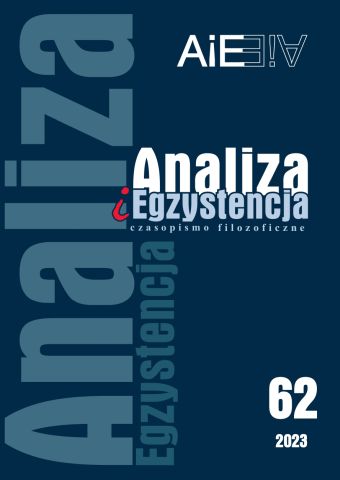
ISSN: 1734-9923
eISSN: 2300-7621
OAI
DOI: 10.18276/aie.2023.62-04





Issue archive /
62 (2023)
Imaging the Absolute: Can Philosophy Visualize Abstractions?
| Authors: |
Leon
Miodoński

Uniwersytet Wrocławski |
| Keywords: | Imagery Iconology Jacob Böhme Romanticism. |
| Data publikacji całości: | 2023 |
| Page range: | 16 (83-98) |
Abstract
This article consists of three parts: the first part presents a synthetic outline of intellectual tendencies in post-Renaissance thought (hermeticism, alchemy, kabbalistics), which generated the iconic turn (emblematics, iconology). Its essence boils down to the integral relationship of the motto (lemma), the engraving (imago), and the poetic text (subscription). The second part is a more detailed analysis of one of the illustrations contained in the first volume of the German edition of Jacob Böhme’s works from 1682 (Amsterdam). The epoch, aesthetic tastes prevailing at that time and the Theosophical content of the work allow us to read this illustration from the point of view of iconology. The third part is devoted to two issues. First, one of the central themes in German idealism was the discussion around the notion of the absolute: whether the absolute can be grasped in concepts (Hegel) or in internal intuition (Schelling). Romanticism was dominated by a tendency to a subjective and speculative approach to the absolute. The philosophy and art of Romanticism was modeled on, among others, medieval German mysticism and Böhme’s theosophy, seeking in these sources the best representation of what is unrepresentable, i.e., the absolute. Secondly, philosophical and artistic Romanticism developed a new type of imagery–language images. The dilemma that resulted from the discussion in German idealism–the notion or inner vision, from the modern point of view, should be solved by a compromise: word and image.
Download file
Article file
Bibliography
| 1. | Alciato, A. (2018). Il Libro degli Emblemi. Secondo le edizioni del 1531 e del 1534. Ed. by M. Gabriele, Nuova edizione riveduta e ampliata, Milano: Adelphi Edizioni. |
| 2. | Böhme, J. (1682). Alle Theosophische Wercken. Darinnen alle tieffe Geheimnüsse Gottes, der ewigen und zeitlichen Natur und Creatur, samt dem wahren Grunde Christlicher Religion und der Gottseeligkeit, nach dem Apostolischen Gezeugnüss offenbahret warden […] In Beyfügung etlicher Clavium so vorhin noch nie gedruckt, nebst einem zweyfachen Register. Amsterdam. |
| 3. | Borgards, R. (2003). Sprache als Bild. Handkes Poetologie und das 18. Jahrhundert. München: Wilhelm Fink Verlag. |
| 4. | Bregman, A. (2007), Emblemata. The emblem books of Andrea Alciato. Newtown. Pa: Bird & Bull Press. |
| 5. | Daly, P.M. (2016). The Emblem in Early Modern Europe. Contributions to the Theory of the Emblem. London, New York: Routledge Taylor & Francis Group. |
| 6. | Geffarth, R.D. (2007). Religion und arkane Hierarchie. Der Orden der Gold- und Rosenkreuzer als Geheime Kirche im 18. Jahrhundert. Leiden, Boston: Brill. |
| 7. | Geheime Figuren der Rosenkreuzer aus dem 16ten und 17ten Jahrhundert (2016). Baden-Baden: Verlag AMORC-Bücher [Facsimile: Geheime Figuren der Rosenkreuzer aus dem 16ten und 17ten Jahrhundert. Heft 1-3. Altona: J.D.A. Eckhardt, 1785-1788]. |
| 8. | Goethe J.W. (2016), Maximen und Reflexionen. Sprüche in Prosa. Ed. by K.-M. Guth. Berlin: Contumax – Hofenberg. |
| 9. | Hegel, G.W.F. (2018). The Phenomenology of Spirit. Translated and Ed. by T. Pinkard. Cambridge: University Press. |
| 10. | Jaspers, K. (2012). Der philosophische Glaube. München, Zürich: Piper. |
| 11. | Knapp, M. (2001). “Der trinitarische Gottesgedanke als Zentrum einer Theologie jenseits der Metaphysik? Eine theologische Auseinandersetzung mit Hegels Trinitätsverständnis”. In: M. Knapp, Th. Kobusch (Eds.). Religion-Metaphysik(kritik)-Theologie im Kontext der Moderne/Postmoderne. Berlin/Boston: De Gruyter, 307-332. |
| 12. | Kuder, U. (2017). „Dürer als Gestalter von Hieroglyphen”. In: I. Roepel, S. McKeown (Eds.). Emblems and Impact Volume I: Von Zentrum und Peripherie der Emblematik [Selected Proceedings of the 10th International Conference of the Society for Emblem Studies 27 July –l August 2014 Christian-Albrechts-Universität zu Kiel]. Cambridge: Scholars Publishing, 257-294. |
| 13. | Mühleisen, Hans-Otto (2012). „Der «Hintersinn» der Bilder. Embleme barocker Klosterbibliotheken. Rätsel und Argument”. In: E. Rudolph, Th. Steinfeld (Eds.). Machtwechsel der Bilder – Bild und Bildverstehen im Wandel. Zürich: Orell Füssli Verlag, 245-271. |
| 14. | Ripa, C. (2012). Iconologia. Ed. by. S. Maffei, Torino: Giulio Einaudi Editore. |
| 15. | Roob, A. (2014). Alchemy and Mysticism. The hermetic museum. Köln Lisboa, London, New York, Paris, Tokyo: Taschen Verlag. |
| 16. | Schelling, F.W.J. (2002). Clara, or On nature’s connection to the spirit world. Translated by F. Steinkamp. Albany: State University of New York Press. |
| 17. | Schelling, F.W.J. (2006). Philosophical investigations into the essence of human freedom. Translated by J. Love, J. Schmidt. Albany: State University of New York Press. |
| 18. | Schelling, F.W.J. (2001). Presentation of My System of Philosophy. Translated by M. Vater. In: The Philosophical Forum, 32(4), Winter, pp. 339-371. |
| 19. | Schlegel, F. (1991). Philosophical Fragments. Translated by P. Firchow. Minneapolis, London: University of Minnesota Press. |
| 20. | Schopenhauer, A. (2010). The World as Will and Representation. Vol.1. Translated and Ed. by J. Norman, A. Welchman, Ch. Janaway with an Introduction by Ch. Janaway. Cambridge: University Press. |
| 21. | Thaler, A. (2018). Die Signatur der Iconologia des Cesare Ripa. Fragmentierung, Sampling und Ambivalenz. Eine hermeneutische Studie. Basel: Schwabe Verlag. |
| 22. | Thimann, M. (2011). “Cesare Ripa und die Begriffsbilder der Frühen Neuzeit. Einige Stichworte zur Einführung”. In: C. Logemann, M. Thimann (Eds.). Cesare Ripa und die Begriffsbilder der Frühen Neuzeit. Zürich: Diaphanes 2011. |
| 23. | Weeks, A., Andersson, B. (2019). “Jacob Böhme’s Writings in the Context of His World”. In: B. Andersson, L. Martin, L.T.I. Penman, A. Weeks (Eds.). Jacob Böhme and His World. Leiden, Boston: Brill, 1-20. |
| 24. | Weeks, A. (2014). “Radical Reformation and the Anticipation of Modernism in Jacob Boehme”. In: A. Hessayon, S. Apetrei (Eds.). An Introduction to Jacob Boehme. Four Centuries of Thought and Reception. New York and London: Taylor & Francis Group, 38-56. |